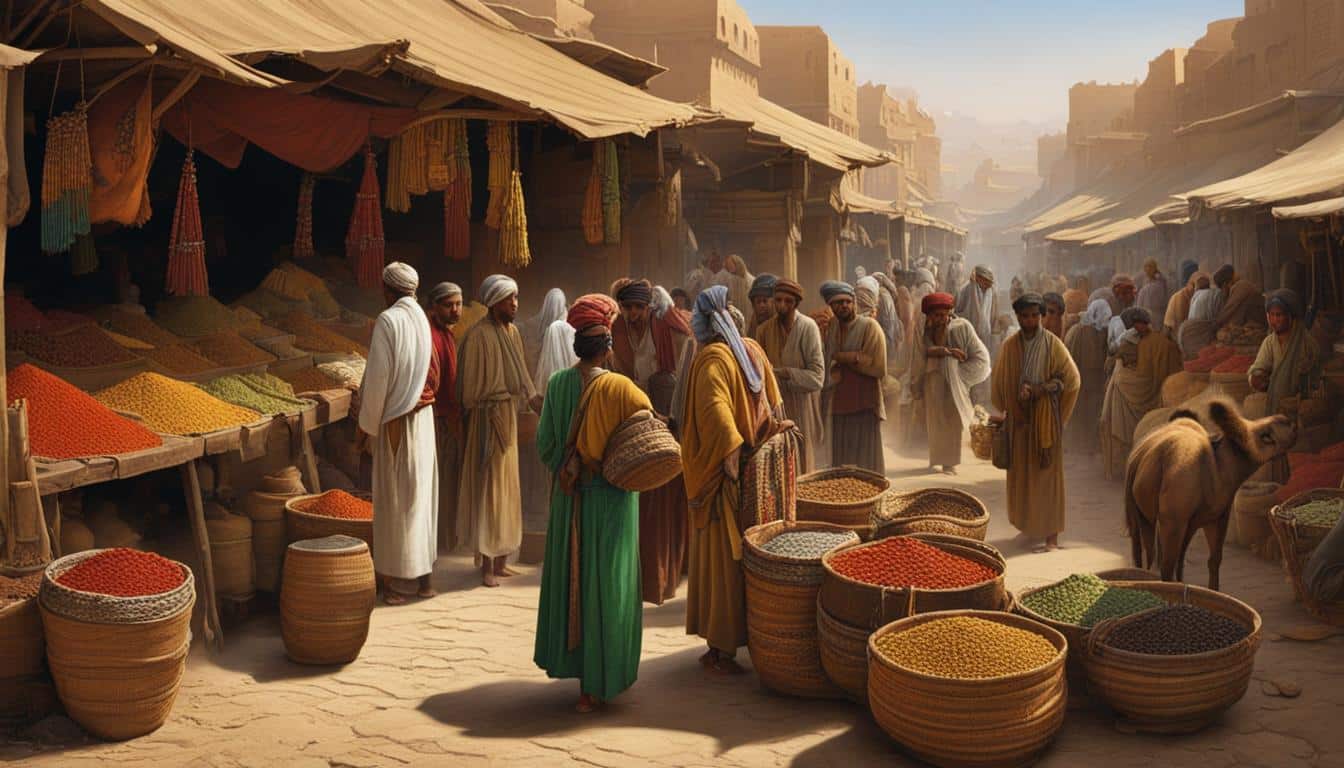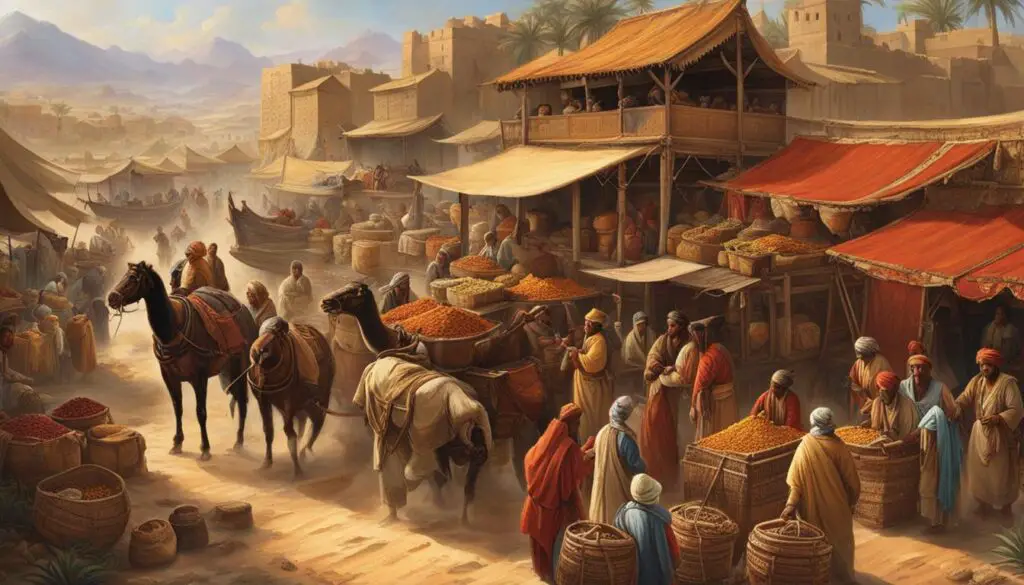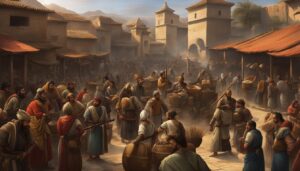
In biblical times, trade and commerce played a pivotal role in the historical economy of Palestine. Situated in the Fertile Crescent, Palestine’s strategic location made it a hub for both international and internal trade. The cities along major trade routes became bustling centers of economic activity, supporting the livelihood of the local population and attracting nomadic traders.
Exports from Palestine primarily consisted of agricultural products such as cereals, flour, oil, wine, and medicinal goods. On the other hand, the inhabitants relied on imports for luxury items and raw materials. Interestingly, the Israelites did not actively participate in trade until the establishment of the United Kingdom, which granted them control over trade routes and the ability to engage in commerce with other nations.
It is fascinating to explore the ancient trade routes and market centers that facilitated trade and commerce during biblical times. These trade routes connected Palestine to Egypt, the Arabian Peninsula, Phoenicia, Syria, Anatolia, and Mesopotamia. Maritime trade with the Mediterranean islands also played a significant role in the economy.
Merchants in market centers along these trade routes engaged in the exchange of goods, forming extensive trade networks that connected different regions. This cultural exchange enriched the local economy and fostered growth.
The economic activities in biblical times revolved around agriculture, with the production of grains, grapes, dates, olives, and lentils being prominent. Livestock farming, including sheep and goats, also contributed to the economy. Trade primarily operated through the bartering system, where goods were exchanged directly without the use of currency. Food, clothing, pottery, woodwork, and leather goods were among the commodities regularly traded.
Key Takeaways
- The strategic location of Palestine in the Fertile Crescent made it a crucial center for trade and commerce in biblical times.
- Exports from Palestine mainly comprised agricultural products, while luxury goods and raw materials were imported.
- Ancient trade routes connected Palestine to various regions, fostering cultural exchange and economic growth.
- The bartering system played a significant role in trade, enabling the exchange of commodities without the use of currency.
- Agriculture, livestock farming, and the production of various goods formed the backbone of the biblical economy.
Ancient Trade Routes and Market Centers
In biblical times, Palestine was connected to various ancient trade routes that facilitated trade and commerce. These trade routes linked Palestine to Egypt, the Arabian Peninsula, Phoenicia, Syria, Anatolia, and Mesopotamia. The maritime trade with the Mediterranean islands also played a significant role in the economy.
The existence of cities along these trade routes, especially harbor cities, made them important market centers for both local and international trade. Merchants in these cities engaged in the exchange of goods and formed trade networks that connected different regions. The markets in Palestine attracted merchants from different cultures, leading to cultural exchange and the growth of the economy.
To illustrate the significance of these ancient trade routes and market centers, let’s take a closer look at some examples:
The Silk Road
The Silk Road was a network of trade routes that connected the East and West, spanning from China to the Mediterranean. Palestine served as a crucial link in this vast trading network, enabling the exchange of silk, spices, precious stones, and other luxury goods between different civilizations.
The Incense Route
The Incense Route, also known as the Frankincense Trail, was a trade route that connected southern Arabia with the Mediterranean. This route allowed for the trade of valuable incense, myrrh, and spices. The city of Petra in present-day Jordan was a major hub along the Incense Route, attracting merchants and contributing to the regional economy.
The Phoenician Trade Network
The Phoenicians, known for their seafaring skills, established a vast trade network that extended throughout the Mediterranean. They traded various goods such as purple dye, timber, glassware, and jewelry. The cities of Tyre and Sidon in Phoenicia served as important trading centers, connecting Palestine to this expansive trade network.
| Trade Route | Main Goods Traded | Significance |
|---|---|---|
| The Silk Road | Silk, spices, precious stones | Connected the East and West, facilitated cultural exchange and economic growth |
| The Incense Route | Incense, myrrh, spices | Connected southern Arabia with the Mediterranean, contributed to regional economy |
| The Phoenician Trade Network | Purple dye, timber, glassware, jewelry | Established extensive trade network throughout the Mediterranean, linked Palestine to trade routes |
These examples illustrate the interconnectedness of ancient trade routes and the vital role that market centers played in facilitating trade and economic development. The trade networks in the Bible shaped the economic landscape of Palestine and contributed to cultural exchange and prosperity.

Economic Activities and Commodities in Biblical Times
In the biblical era, a variety of economic activities and commodities flourished in Palestine, contributing to the growth of the local economy. The agricultural sector played a pivotal role, with the production of staple crops such as grains, grapes, dates, olives, and lentils. These agricultural products not only sustained the local population but also served as significant exports.
Livestock farming, particularly sheep and goats, also played a crucial role in the economy of biblical times. The rearing of these animals provided not only sustenance in the form of meat, milk, and wool but also served as a valuable source of trade and commerce.
The bartering system was widely used for trade during this period. Unlike the modern monetary system, the bartering system relied on the direct exchange of goods without the use of currency. This system allowed for the exchange of commodities such as food, clothing, pottery, woodwork, and leather goods.
Furthermore, the flourishing trade activities in Palestine fostered cultural exchange among different regions. This exchange of products and goods enriched the local economy and nurtured a vibrant marketplace filled with merchants from diverse cultures.
FAQ
What role did trade play in biblical times?
Trade was crucial in biblical times, especially in Palestine, as it provided a livelihood for the local population and allowed for the exchange of goods between different regions.
What were the main commodities traded in Palestine?
The main commodities traded in Palestine included agricultural products such as cereals, flour, oil, wine, and medicinal products.
Which trade routes were connected to Palestine in biblical times?
Palestine was connected to various ancient trade routes that linked it to Egypt, the Arabian Peninsula, Phoenicia, Syria, Anatolia, Mesopotamia, and the Mediterranean islands.
How did the bartering system function in biblical times?
The bartering system, where goods were exchanged directly without currency, was commonly used for trade in biblical times and allowed for the exchange of commodities such as food, clothing, pottery, woodwork, and leather goods.
Did the Israelites participate in trade during biblical times?
The Israelites did not actively participate in trade until the establishment of the United Kingdom, which allowed them to control trade routes and engage in commerce with other nations.








